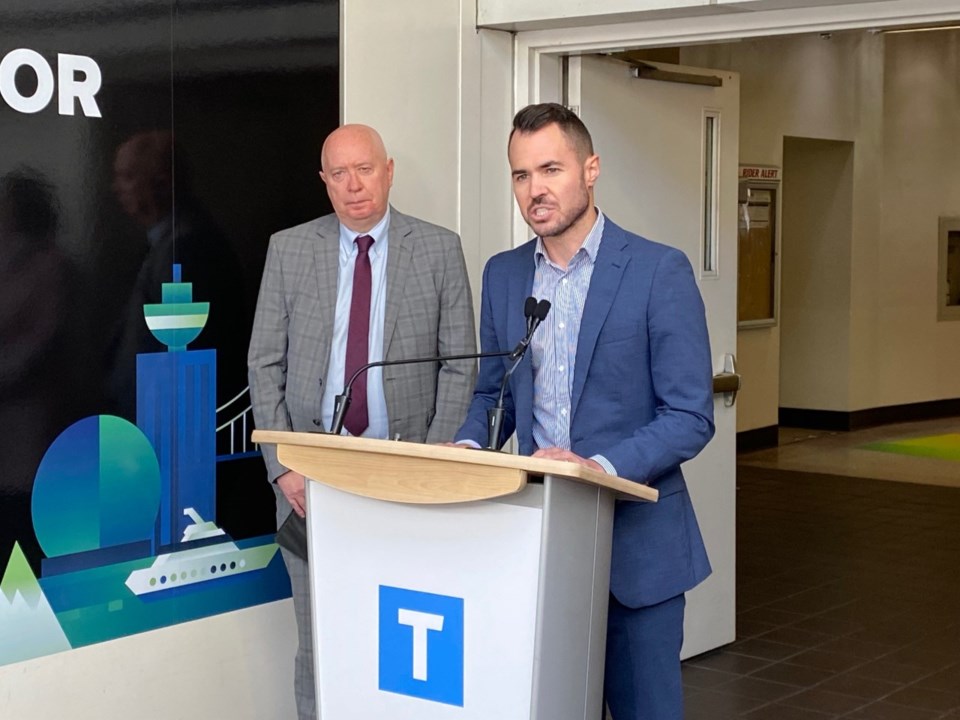Metro Vancouver mayors are flying to Ottawa next week to call on the federal government to expedite a $3-billion permanent public transit fund, claiming higher immigration rates will put more pressure on TransLink’s infrastructure needs.
The funding is scheduled to start in 2026, but Port Coquitlam Mayor Brad West, chair of the Mayors’ Council, says the funds will be needed next year.
Since TransLink serves about 2.6 million people, representing about seven per cent of Canada’s population, a representative cut of the annual fund would be $205 million.
TransLink intends to use the money to more than double its bus service over 2022 levels by 2032 with a $21-billion plan.
However, the 10-year plan under its Transport 2050 strategy, dubbed Access for Everyone, assumed federal immigration targets would remain around 300,000 annually.
“The government’s new higher target of 500,000 per year will mean faster population growth in Metro Vancouver than planned for, which will put additional strain on our transportation network,” stated the Mayors’ Council Wednesday.
TransLink says it’s now expecting 50,000 new residents to the region as opposed to 30,000.
2022 ridership rebound still not enough to stave off operating deficits
TransLink’s capital projects also rely on keeping its head above water on the operations side, which is why it has also needed more senior government money to address operating deficits it has been running since the COVID-19 pandemic slashed transit revenue (fares) from $685 million in 2019 to $385 million in 2020 (and $413 million in 2021). Before the pandemic, TransLink was achieving operating surpluses of close to $190 million annually.
In 2022, there were 325.9 million total boardings, 45.8 per cent higher compared to 2021, with transit revenue rising to $552 million. Ridership, however, still remains about 20 per cent below pre-pandemic levels.
TransLink received $479 million from the provincial government in March to maintain services and capital projects over the next three years in the face of the continued revenue shortage. This was in addition to $644 million it received in 2020 and $176 million in 2022, from senior governments.
The trick for TransLink is maintaining service levels to welcome back riders; should it cut service (bus routes) it risks losing even more riders, officials have stated.
More subsidies to fix deficits may necessitate more direct elected oversight of TransLink: West
Ahead of the trip, West told Glacier Media ongoing operating funding remains a concern.
When asked what TransLink is doing to , West said it’s his and the council’s expectation that is being done.
"That’s not something the provincially created governance model allows us to do. We can say that’s our expectation but we are not in control of TransLink," said West.
Getting more oversight of TransLink from elected officials is also a concern of his, West said, noting the council does not oversee operating expenses, as it largely only approves long-term strategies and investment plans.
Rather, TransLink is overseen by a board of directors appointed by a screening panel, which includes a council representative and the Minister of Transportation; West and two other mayors are part of the 12-person board.
“We need to address the democratic deficit that exists in the governance structure of TransLink,” said West.
“We're going to continue to press for the government legislative changes that are required to restore more local accountability and representation to the taxpayers who are funding the system,” he added.
“There was a time …the mayors had that sort of oversight and control. And I think that was a very poor decision to take it away because it served as an important accountability mechanism to taxpayers and residents,” he said.
When asked where any additional funding will come from, West said his preference would be that it come from general income tax revenue. He said property taxes, any sort of road use charge and a higher fuel tax penalize working class people and families, who most likely need a vehicle due to living outside the urban core where housing is more expensive.
Likewise, West said increasing fares beyond small increases to account for inflation would harm ridership and "hurt those who can afford it the least."
"As a federal government, provincial government, and as a regional local government, we have got to go back to the drawing board," said West of the upcoming meetings with federal representatives.
Last year, TransLink raked in $424 million from the fuel tax (up from $368 million in 2019) and $437 million in property tax, which made up about half of all its revenue outside government relief funding.
In 2022, total revenues came in at $2.13 billion and total expenses were $2 billion. The $130-million surplus was due to the three-year $176-million senior government relief fund being entirely counted in the first year.
What is Access for Everyone?
TransLink says the Access for Everyone plan will:
- more than double bus service over 2022 levels;
- add up to nine new traffic-separated Bus Rapid Transit lines;
- make improvements to the region's major road network;
- increase HandyDART service by 60 per cent and provide 24-hour service;
- begin planning for a rapid transit solution to the North Shore (Metrotown to Park Royal);
- build the Burnaby Mountain Gondola to Simon Fraser University;
- extend SkyTrain to the University of British Columbia;
- increase SeaBus service start and end times to match SkyTrain’s service hours; and,
- expand cycling and pedestrian infrastructure.

